





|
|
| |
My love of finches started with two Pied Gray Zebra finches that
my husband, Bill bought for me a few years ago. The
female's bright orange beak reminded me of a carrot, so I named
her Anne, after the "carrot topped" character Anne of Green
Gables. Of course, that meant that the male had to be
named Gil. I now keep and breed several different types of
finches, but I think I will always keep some Zebra finches
around. |
| |
|
|
| |
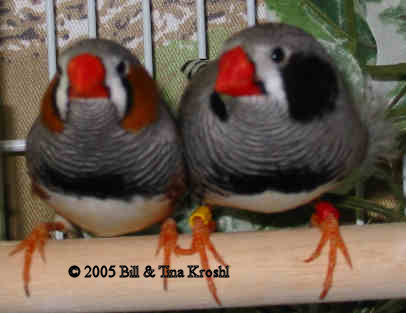 |
 |
| |
Normal Grey Zebra
(Male) with a Black Cheeked Zebra (Male). Note the
bright red beaks: this is an indication that the
males are in prime breeding condition. Male's
beaks are normally red. |
This is a photo of two Zebra finch hens. The one at the left
(with the "tear marks") is a Regular Chestnut Flanked White (RCFW)
and the other is Pied Fawn. |
| |
|
|
| |
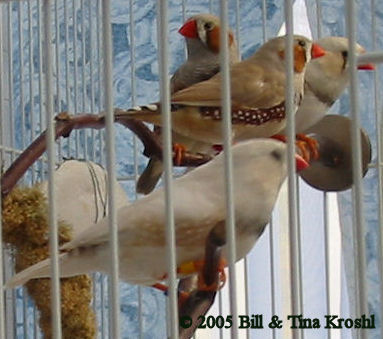 |
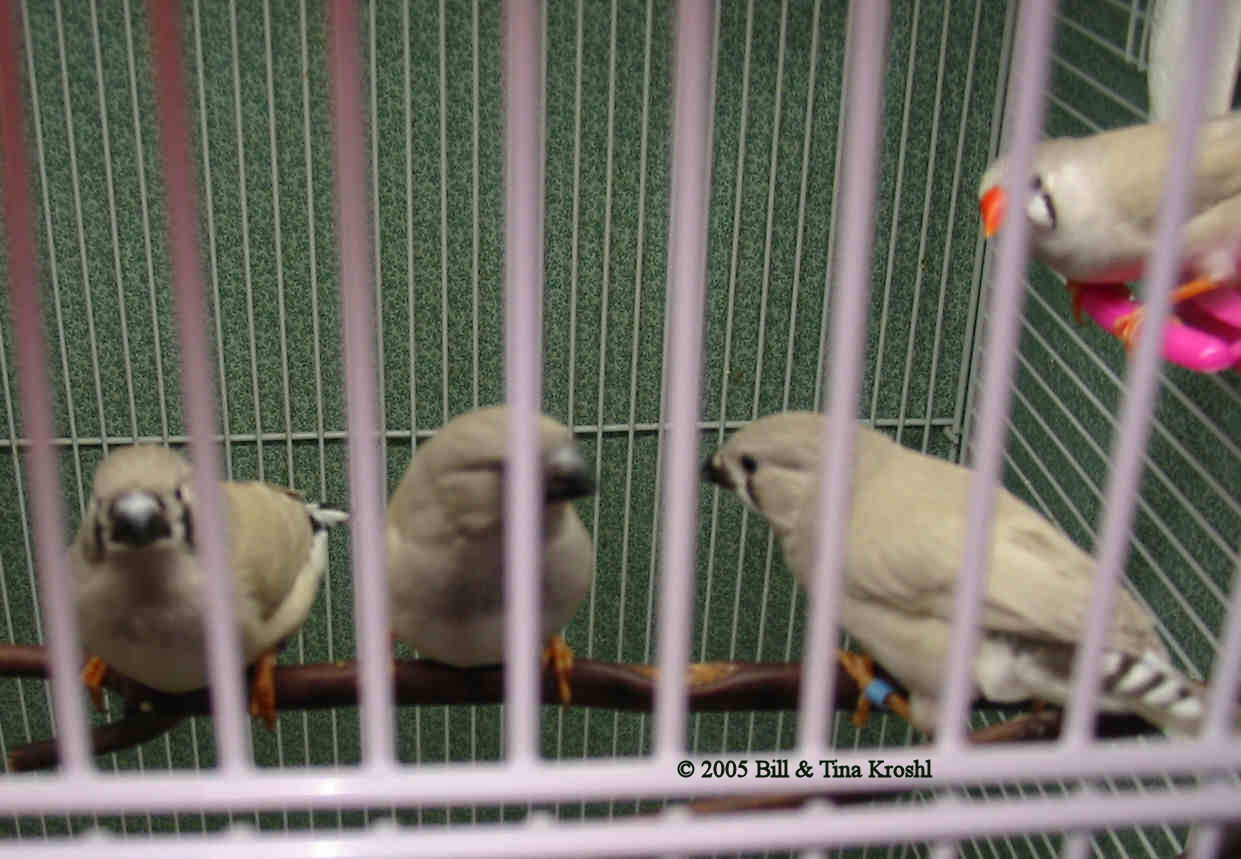 |
| |
This is a group of male zebra finches. The
light one in the foreground is Regular Chestnut Flanked White (RCFW)
which shows poor coloration. The others are a Fawn,
another RCFW, and a Light Back Grey. |
Three nestlings: note their black beaks.
All baby zebra finches have black beaks except for Continental
Chestnut Flanked Whites (CCFW), which have a clear pink beak,
and Fawns, which have a brown beak. They turn their normal
color (red for males, orange for females) as they mature.
This photo shows three nestlings, all Light Back Greys, as their
mother looks on from the right. |
| |
|
|
| |
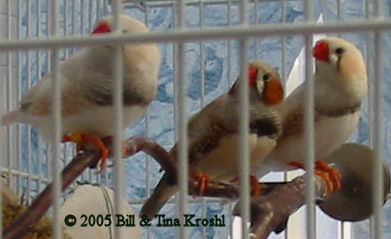 |
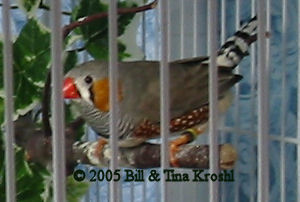 |
| |
Another view of the same zebra finches as above.
The center bird is a Fawn, and the other two are Regular
Chestnut Flanked Whites (RCFW). |
A Normal Grey Male Zebra Finch. |
| |
|
| |
Zebra finches are cute and adorable little finches. They are
easy to raise and require minimal care. They originated in the
grasslands of Australia, where they still can be found in the
wild. However, for many years they have been protected, and all
the zebra finches you find for sale today have been bred in
captivity.
They come in a variety of colors from gray, fawn, white and many
variations in between. The zebra male is easy to spot with his
bright orange, black, fawn, or gray cheek patches. He will have
throat stripes from his beak to his belly, (unless he is a
Florida Fancy or Penguin,) that will remind you of a zebra. He
also has chestnut or black flanks that are poke-a-dotted and a
"tear drop" from his eye. Their tails are usually black or brown
and have white spots. The hen looks like the male but doesn’t
have the cheek patches, throat stripes, or the flanks. Except
for the black cheek, fawn cheek, or gray cheek hens they will
have the cheek patches also.
Zebra finches are usually about 4” long from beak to tail. The
male has a cute little song and the hen just “meeps”. The males
will have bright red beaks and the hens have orange beaks. Zebra
are social finches and need to be in pairs. However, that
doesn’t limit you to just male female pairs. I would strongly
recommend that if you are going to go with just one sex that you
get three of the same sex, they seem to get along a lot better
as a trio.
Zebras are known for being easy and hardy breeders. Just put a
male and a female together and soon you will have eggs. Zebras
should have a nesting box of some kind. I don’t recommend using
the wicker nests that are sold at the pet stores, because their
nails can get caught in the wicker and this can kill the bird or
cut them. Another option to make your nest boxes out of
cardboard. The
directions for these can be found at
www.ringneckdove.com. Zebras will build nests just about any where including
their food dishes. I usually remove the food cups that come with
the cages because I have found that they encourage egg laying.
Zebras usually lay 4 to 6 eggs but have been known to lay as
many as 8 at a time. They usually start sitting on the eggs
after the third or fourth egg has been laid. Once they start
sitting on the eggs it takes about 14 days for the eggs to start
hatching. However I have had them hatch as late as 18 days. By
waiting to start sitting the birds help to ensure that most of
them will hatch with in a day or two of each other. This becomes
important as the hatchlings mature. The first two or three days
the hatchlings beg so quietly that you mostly won’t hear them.
But as they get older their begging gets louder. The parents
usually start feeding the loudest ones first. A younger one
usually can’t beg as loudly as the older ones and it gets fed
last.
When zebras are hatched their skin will be gray, brown, or pink
(depending on the color mutation) and except for the
Continential Chestnut Flanked White (CCFW) they will have black
or brown beaks and a little bit of down feathering. The first
day the parents rarely feed them because they eat the egg sack.
But it will be easy to see that the parents are feeding them.
They will have a swollen area in their neck that will look like
it is full of white bumps. That is the food in their crops
before they completely digest it.
|
| |
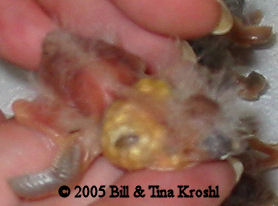 |
This photo is a five day old Regular Chestnut
Flanked White (RCFW) Zebra Finch. Note the full crop (the
white bumps). |
| |
|
|
| |
Currently I am working on breeding
Continental Chestnut Flanked White Zebra finches, Black Cheek
Zebra finches, and a Black Cheeked Continental Chestnut Flanked
White Zebra finch. My son Mark is currently breeding a
pair of Light Backed Zebra Finches. |
| |
|
|
|







